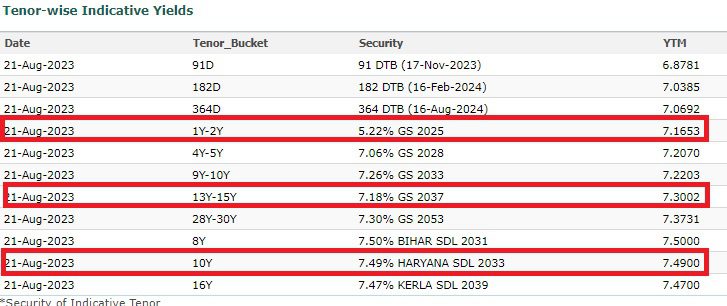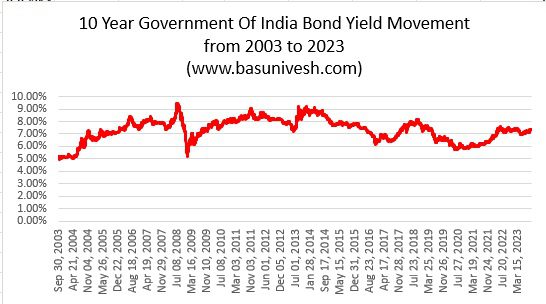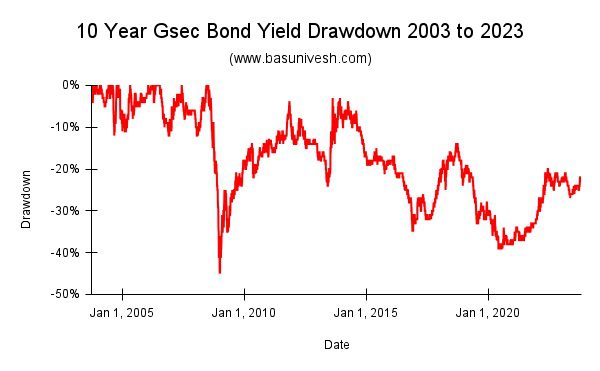[ad_1]
Authorities of India is providing the longest bond of fifty years “New Authorities Safety 2073”. This Authorities of India Bond 2073 is offered at a 7.52% yield. Who can make investments?
The bond particulars as per RBI Retail Direct are as under.
Safety Identify – NI GOVT. STOCK 2073
Maturity Date – sixth November 2073
Indicative Yield (as of 1st October 2023) – 7.52%
ISIN Quantity – IN0020230127
You should purchase this bond in RBI Retail Direct Platform with none price concerned. (“RBI Retail Direct – Make investments In Authorities Bonds On-line).
As of now, the longest bond providing by the Authorities Of India is 40 years. First-time authorities is providing a 50-year maturing bond. Two extra auctions of 50-year tenure bonds may even be introduced at later dates for the second half of FY2024.
New Authorities Of India Bond 2073 – Who can make investments?
Simply because it’s supplied by the Authorities Of India and default or downgrade danger is sort of NIL doesn’t imply it’s SAFE. You possibly can keep away from the default or credit score downgrade danger as it’s issued by the Authorities. Nevertheless, you may’t run away from rate of interest danger.
Therefore, allow us to attempt to perceive the professionals and cons of investing within the New Authorities Of India 2073 Bond.
# Curiosity or Coupon Revenue
Curiosity shall be payable on half yearly foundation. It’s not like your Financial institution FD the place you accrue the gathered curiosity and get again maturity. Therefore, in case you are in want of such frequent earnings, then you may go for it. If you’re within the accumulation section of your life and making an attempt this bond only for diversification or as a debt half, then it’s of no use for you.
Many might argue that they will reinvest the identical. Nevertheless, observe that this curiosity earnings is taxable for you. Therefore, post-tax you need to make investments, and reinvestment danger is all the time in your head. Once you purchase a debt mutual fund, the fund supervisor additionally receives the coupon. Nevertheless, he reinvests which won’t alter your taxation. However if you happen to want to do the identical, then you need to pay the tax after which reinvest.
# Taxation
As I discussed above, the curiosity or coupon you obtain is taxable as per your taxable. Therefore, take a look at post-tax returns than the pre-tax returns.
Together with this, if you happen to promote the bonds within the secondary market earlier than maturity, then you need to pay the tax on capital positive aspects.
When you promote bonds inside a 12 months of buying them, the positive aspects shall be handled as short-term capital positive aspects and shall be taxed at your earnings tax slab price. Nevertheless, if you happen to promote your bonds after a 12 months of holding them, the positive aspects shall be handled as long-term capital positive aspects and shall be taxed at a decrease price of 10% (with out indexation profit).
# Curiosity Fee Threat
I wrote an in depth publish on this “Half 3 – Debt Mutual Funds Fundamentals” or I pasted the identical right here to your reference.
Assume that Mr.A is holding a 10-year bond that gives him 8% curiosity with a face worth of Rs.100. Mr.B is holding a 10-year bond that gives him 6% curiosity with a face worth of Rs.100. Assume that the Financial institution FD price is at 7%.
Allow us to assume that for numerous causes Mr.A and Mr.B are prepared to promote their bonds within the secondary market.
Because the Financial institution FD price is presently at 7%, many will attempt to purchase Mr.A’s bond quite than Mr.B’s bond. Even few could also be able to pay greater than what Mr.A invested (assuming he invested Rs.100). Primarily as a result of the financial institution is providing 7% and Mr.A’s bond is providing increased than this (8%).
Due to this, Mr.A might promote at a premium value than he truly invested. Say for Rs.106. Now, the customer of the bond from Mr.A will suppose otherwise. As Rs.100 face valued bond is offered at Rs.106, which affords 8% curiosity for the following 10 years, and at maturity, the customer of the bond will get again Rs.100 again, then he begins to calculate the RETURN ON INVESTMENT. For the customer, his funding is Rs.106, he’ll obtain 8% curiosity on Rs.100 face worth and after 10 years he’ll obtain Rs.100 face worth. His return on funding is 7.14%. That is clearly just a little bit increased than the Financial institution FD price. Therefore, he might purchase it instantly.
Suppose the identical purchaser needs to purchase Mr.B’s bond, to make it enticing to the customer, Mr.B has to promote his bond at Rs.92 (with a lack of Rs.8). Rs.92 priced bond, 6% curiosity, face worth of Rs.100 and tenure 10 years will fetch the identical 7.14% returns for a purchaser.
You observed that the figuring out think about each transactions is the Financial institution FD price of seven%. Therefore, the rate of interest coverage of RBI is crucial issue for the bond market. Bond costs change each day primarily based on such rate of interest motion.
This danger is relevant to all classes of bonds (together with Central Authorities or State Authorities Bonds).
In easy, at any time when there’s an rate of interest hike from RBI, the bond value will fall and vice versa. From the above instance, not directly you discovered two ideas. One is rate of interest danger and the second is YTM (Yield To Maturity). YTM is nothing however the return on funding for a brand new purchaser of the bond from the secondary market. Within the above instance, the customer’s return on funding is nothing however a YTM. As the value of the bond modifications each day, this YTM additionally modifications each day.
# Yield To Maturity (YTM)
For this additionally, I wrote an in depth publish “Half 4 – Debt Mutual Funds Fundamentals“. Nevertheless, I’ll clarify the identical intimately.
For a brand new bond investor, yield to maturity in a easy approach say is the return on funding if he holds the bond until maturity. that once you purchase a bond, then you’ll get curiosity at a sure interval (within the majority of bonds) and at maturity, you’ll get again the face worth of the bond.
Allow us to assume {that a} 10-year bond is presently buying and selling at Rs.105, the time horizon is 10 years and the coupon (rate of interest) is 8%, then the customer has to calculate the return on funding. The client can pay Rs.105 (for Rs.100 face worth bond), he’ll obtain 8% (on Rs.100 face worth however not on Rs.105) yearly, and at maturity after 10 years, he’ll obtain Rs.100 (face worth however not the invested quantity of Rs.105).
The YTM calculation is just a little bit difficult to grasp for a lot of traders. As an alternative, there are on-line readymade calculators out there to grasp the YTM. If we go by the above instance, then the yield to maturity for a purchaser or return on funding for a purchaser is 7.8% IF HE HOLD THE BOND UP TO MATURITY.
Clearly, patrons by calculating the YTM examine with the present prevailing rate of interest. If YTM is best then he’ll purchase in any other case he’ll negotiate the value with the vendor to make it extra worthwhile for him.
Now within the above instance, you observed that price of curiosity on the bond is 8% however YTM is 7.8%. It’s primarily as a result of if a purchaser is shopping for at face worth, then for him the YTM shall be 8%. Nevertheless, within the above instance, as he’s shopping for at a better than the face worth, his return on funding is proportionately diminished.
Therefore, at any time when somebody buys a bond, it’s YTM issues much more than the coupon price. Nevertheless, if somebody is shopping for the bond at issuing value, then YTM equals to the coupon price. To grasp this idea in a greater approach, allow us to take into accounts the present YTM of the assorted maturing bonds.

The above checklist contains the most recent YTM of varied maturing bonds. Simply think about the bonds that I’ve highlighted.
The 2025 maturing bond YTM is now at 7.16%. However the coupon price is 5.22%. It clearly signifies that the bond is offered at a decrease than the face worth. If we calculate the value, then the bond is offered at round Rs.97 (the face worth is Rs.100).
Similar approach, if look into the 15-year maturing bond, you discover that the YTM is 7.3% however the rate of interest is 7.18%. this once more exhibits that the bond is offered at a reduced value.
Nevertheless, if you happen to take a look at the 10-year Haryana state authorities bond (which is normally known as SDL), the YTM is the same as the rate of interest. It means the bond is offered at face worth.
Now, your debt mutual fund is holding a bunch of bonds, proper? Then how the fund will arrive on the YTM of the fund? The fund supervisor will calculate the weighted common of bonds is calculated. It signifies that primarily based on the weightage of the actual bond in a fund’s portfolio, the YTM is taken into account proportionately to reach on the whole YTM of the fund.
Vital Factors About YTM
- YTM is a return a bond investor can anticipate IF he’s holding the bond until maturity. Nevertheless, if he’s promoting it earlier than maturity, then his YTM will differ primarily based on the prevailing value of the bond (do keep in mind that bond value modifications each day and therefore the YTM too) on the time of promoting.
- YTM won’t take into accounts the taxation half.
- Additionally, YTM won’t take into the shopping for and promoting prices.
- Few argue that increased YTM means dangerous and decrease YTM means non-risky. I don’t imagine on this plain judgment. As an alternative, we’ve got to search for the credit score high quality of the bond and the time horizon left to mature. After all, the decrease YTM bond could also be much less unstable. Nevertheless, what issues is the standard of the bond and the time horizon for maturity.
# Volatility
The most important concern particularly once you put money into bonds is volatility. As I discussed above, if the bond tenure is long-term, then volatility will improve drastically. Simply to provide you an instance, I’ve taken the final 20 years’ bond yield motion of the 10-year authorities of India bond (normally it’s a benchmark that’s thought-about in lots of fields of the funding world).
The under chart exhibits the yield motion of the identical of final 20 years.

You observed that the yield was round 5% throughout 2003 and it went as much as greater than 9% throughout 2008 and once more got here down.
Nevertheless, it’s possible you’ll not visualize the volatility so simply. Therefore, as an alternative of the above chart, I created a drawdown chart of the yield of the final 20 years. Drawdown means how a lot % it has fallen from its earlier peak.

Discover the sharp fall in yield of just about 40% through the 2008-2009 interval and the following massive fall is through the 2020 interval.
Think about the volatility of the New Authorities Of India Bond 2073 as its 50-year maturing bond. I considered exhibiting the present 40 years of Authorities Bond volatility. Nevertheless, because the 40-year maturing bond was first time launched in 2015, I assumed that will not present a transparent image as information factors are usually not a lot. Therefore, in contrast with 10 years bond.
# Liquidity
Liquidity is the most important concern for such long-term bonds. Therefore, with the present enticing yield if you happen to make investments and if you happen to want the cash earlier than maturity, then you need to battle loads to promote the bonds within the secondary market. Additionally, as I discussed above, primarily based on the rate of interest cycle, it’s possible you’ll achieve or lose.
Conclusion – By no means make investments on this bond simply because the yield is enticing and with concern of lacking this present yield sooner or later. Attempt to first take a look at your necessities, taxation, danger, volatility, and liquidity. Then take a name. Such long-term bonds are usually meant for Workers Provident Fund Organisation (EPFO), insurance coverage firms, pension funds and even charitable trusts.
Nevertheless, in case you are SURE to carry this bond for the following 50 years, then consider getting into into this bond as danger is minimal in such a state of affairs. Are you SURE?? If reply is YES, then go forward.
[ad_2]

